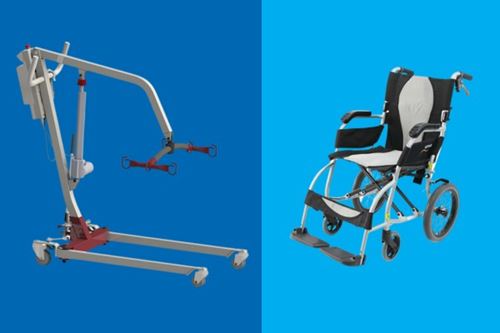-
Home
-
The Importance of Patient Lifts and Transfer Chairs in Healthcare
The Importance of Patient Lifts and Transfer Chairs in Healthcare
October 10, 2023
 When lifting or transferring patients with little or no mobility, the right equipment makes all the difference. Patient lifts and transfer chairs are essential tools that help make these processes easier, safer, and more comfortable for both the caregiver and the patient. In this article, we’ll take a closer look at these devices and their importance in safe patient handling.
When lifting or transferring patients with little or no mobility, the right equipment makes all the difference. Patient lifts and transfer chairs are essential tools that help make these processes easier, safer, and more comfortable for both the caregiver and the patient. In this article, we’ll take a closer look at these devices and their importance in safe patient handling.
What are Patient Lifts?
Patient lifts are designed to assist in lifting and transferring patients with mobility issues. They use a sling attached to a lifting mechanism to lift and/or move patients from one location to another without putting unnecessary strain on the caregiver.
There are several different types of patient lifts designed to accommodate each patient’s needs and mobility level. Bariatric models are also available with reinforced support and higher weight capacities to ensure safe and comfortable transfers for larger patients.
Types of Patient Lifts
Hydraulic Lifts use hydraulic fluid with a cylinder and pump system to power the lifting mechanism. These lifts require caregivers to manually operate the pump or lever to raise or lower the patient.
Electric Lifts use an electric motor, rather than a manual mechanism, to raise and lower the patient. These lifts are usually operated with a handheld control unit, making them easier to use for caregivers.
Sit-to-Stand Lifts are specifically designed to assist patients who have some weight-bearing capacity but may struggle when transitioning from a seated position to a standing position. These lifts can be hydraulic or electric.
Full-Body Patient Lifts are designed to assist in patient transfers who require full-body support. are typically used in healthcare settings, nursing homes, and home care environments to safely move patients with limited mobility.
Trapeze Patient Lifts help patients change positions while in bed and aid in transfers onto or off of the bed. These lifts consist of a free-standing overhead trapeze bar or a trapeze bar with a stand that can be adjusted to the desired height.
Precautions When Using a Patient Lift
Patient lifts are an excellent way to ease the physical strain of lifting and transferring completely or partially immobile patients. However, it is important to take precautions when using these devices. Some of these precautions include:
- Being mindful of the patient's weight and selecting a lift with enough capacity to lift the patient safely
- Evaluating the patient’s mobility level before selecting a lift
- Ensuring that the sling is secured before attempting to lift or transfer a patient
- Ensuring that the chair is properly maintained to prevent unexpected malfunctions.
What are Transfer Chairs?
Transfer chairs, also called transport chairs, are used to easily move patients with limited or no mobility from one location to another. While they are similar to wheelchairs, transfer chairs are generally lighter weight, have smaller wheels, and always require assistance from a caregiver. They are not designed for independent or continuous use as a mobility aid, but are used to transfer patients over short distances as needed.
Caregivers generally need to use a transfer device, such as a lift, to get the patient safely into the chair and ready for transport. Transfer chairs come in different types and sizes to accommodate a patient’s specific needs.
Types of Transfer Chairs
Standard Transport Chairs are lightweight and fold up for easy storage, making them a convenient option for transporting patients.
Ultra-Light Transport Chairs are made from premium materials like aircraft-grade aluminum, making them even lighter than standard transport chairs while still offering the same benefits.
Bariatric Transport Chairs have higher weight capacities and larger sizes to safely and comfortable transport bariatric patients.
MR-Safe Transport Chairs are constructed using nonmagnetic material and are specifically designed for use in the MRI suite.
Patient lifts and transfer chairs are essential pieces of equipment when caring for patients with mobility challenges. These innovative devices help facilitate safe, efficient, and successful transfers, improving outcomes for both staff and patients.
Want more information? Visit AliMed’s Safe Patient Handling Resource Hub offering comprehensive resources for healthcare providers and caregivers.